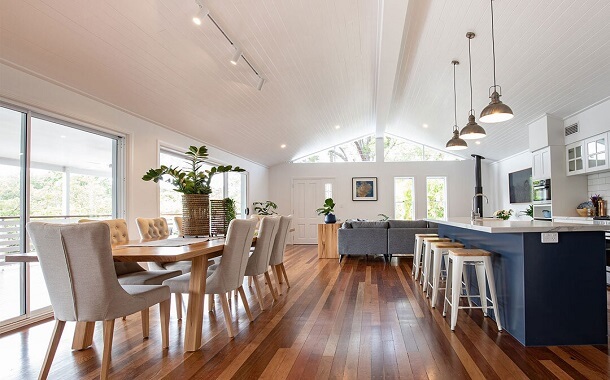How Much Does it Cost to Raise a Ceiling Height?
Last Updated on December 27, 2023
Written by CPA Alec Pow | Content Reviewed by ![]() CFA Alexander Popinker
CFA Alexander Popinker
Low ceilings may make even the largest, open-plan home feel small. Usually, homes have a standard eight to nine-foot ceiling, which may not be high enough for you, or you just want to change the overall atmosphere of the house. In this case, you may consider vaulting your ceiling.
Depending on the pitch of your existing roof, it may be possible to vault your ceilings as high as 12 feet. By raising the ceiling, you will have more space and extra natural light.
How Much Does it Cost to Raise a Ceiling Height?
The cost of raising a ceiling is from as little as $3 to as much as $70 per square foot, depending on several factors. Among the most important factors are the roof framing, the size of the room, your location, and the hired builder. Also, there are three methods to raise your ceiling.
The tray ceiling average cost is from $3 to $7 per square foot or $700 to $1,600 on average for a 15’ x 15’ room to build. This method is a more affordable one, and it is easier to build during a remodel. Tray ceilings are constructed by installing a drop-down frame border to a current ceiling. The cost mentioned above is for both materials and installation. There are several factors that affect the total cost, and we have listed them in the table below.
| FACTOR | COSTS |
|---|---|
| Carpenter | $30 to $100 per hour |
| Structural engineer | $100 to $220 per hour |
| Architect | $100 to $250 per hour |
| Interior designer | $50 to $200 per hour |
| Drywall | $2 to $4 per square foot |
The second method is the coffered ceiling, and the costs are somewhere from $10 to $40 per square foot or $1,500 to $6,000 for an average room of 150 square feet. A coffered ceiling is made of recessed boxes created by ornamental beams. They can be found in several kinds of colors, materials, shapes, and patterns. When it comes to materials, there are several options available. Also, the type of material will significantly increase the cost.
| MATERIAL | COST PER SQUARE FOOT |
|---|---|
| Drywall | $0.50 to $0.80 |
| Plywood | $2.00 to $4.50 |
| MDF | $1.00 to $5.00 |
| Oak | $3.00 to $9.00 |
| Cherry | $3.00 to $11.00 |
| Walnut | $3.50 to $13.50 |
| PVC | $14.00 to $21.00 |
| Mahogany | $2.00 to $20.00 |
The third method is the vaulted ceiling, which is more complex and the average cost is anywhere from $40 to $70 per square foot or $16,000 to $28,000 for a 20’x20’ room. In this case, the attic space is eliminated and the ceiling follows the slant of the roof. For a better estimate, we listed in the table below some factors that will influence the overall cost.
| FACTOR | AVERAGE COST |
|---|---|
| Demolition & Disposal | $4.00 to $10 per square foot |
| Insulation | $1.00 to $4.00 per square foot |
| Drywall | $1.50 to $3.50 per square foot |
| Painting | $1.00 to $2.00 per square foot |
| Architect | $100 to $250 per hour |
| Structural Engineer | $100 to $220 per hour |
An important thing to note is that you should take these costs as an estimate as there are several major factors that can influence the overall cost. For a more accurate cost, we recommend contacting a professional company and going through the needs of your project.
HouseTweaking.com unveiled some before and after pictures with their vaulted ceiling in the living room. The overall cost was $6,500, however, the demolition, insulation, and the extra repair for the damaged walls were not included.
You might also like our articles about the cost of popcorn ceiling texture removal, stretch ceilings, or bearing wall removal.
On BiggerPockets.com, a member stated that they were able to raise ceiling and remove the old frames, for the cost of $8,000.
An Angi member revealed that only for raising and reframing your ceiling you can expect to pay from $9,000 up to $12,000, and you can expect the cost to double in some complex cases.
Additional costs to consider
 Before you run this type of project, ensure that your house is a good candidate. Hire a contractor to evaluate your house/room, in order to be prepared for all the extra costs.
Before you run this type of project, ensure that your house is a good candidate. Hire a contractor to evaluate your house/room, in order to be prepared for all the extra costs.
Having a chimney and vaulting your ceiling will be a larger job. Take into consideration that the chimney structure may need to be adjusted, and this job can add an extra $500 to $600 to your overall cost.
Another extra expense will be related to the electrical system. Raising your ceiling, you will need to extend the cables along it, and usually, an electrician charges $40 to $100 per hour. Also, you may consider adding new lighting such as a chandelier that typically costs from $220 to $3,400 or a skylight for $1,600 to $4,200, including the installation fee. These new lights will greatly increase your budget.
An additional cost may be considered for the plumbing. Most houses have vent pipes that will need to be rerouted. This work, with fixtures and installation included, can get somewhere between $450 to $1,800.
With all these changes, raising your ceiling and changing the plumbing and electrical system, you have to take into consideration procuring a building permit. These permits, depending on how complex is the work, will add an extra cost of $200 up to $1,500.
Other add-ons for design purposes may be considered and will increase the overall cost.
Important things to consider
Real estate agents have stated that raising your ceiling will definitely add more value, about 20 to 30 percent, to your home. Furthermore, the home will sell for more money because of the aesthetic these improvements feature.
Keep in mind that completing the job of raising a roof may take 30 to 45 days. However, depending on the complexity of the project, this time range may be extended.
Often people install windows on the high ceiling in order to have more natural light. This type of change may lower your lighting expense, as you will not need to use that much artificial light throughout the day.
Having a higher ceiling will give the feel of a bigger space without needing to expand out.
A good thing to know from the beginning is that if you raise your ceiling you may also raise your heating bill.
Before hiring a contractor, take into consideration asking for at least three to five estimates, in order to compare and get the best deal.
You may want to consider reading reviews on HomeGuide, to see people’s past experiences with this project.
Always get a written contract, a detailed estimate, and a warranty before paying any amount of money.


Leave a Reply
Want to join the discussion?Feel free to contribute!